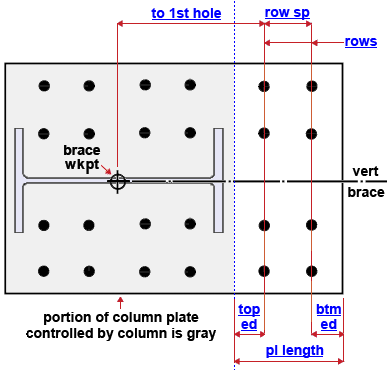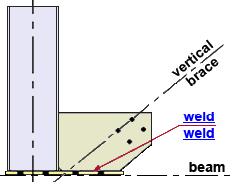"  Cap Plate " connection design locks
Cap Plate " connection design locks
|
" |
|
||||
|
" (auto base/cap plate controlled by brace)  |
(shop weld, gusset to column plate)  |
|||
|
||||
|
||||
User Defined Connections: Settings that are locked (
) in the user defined connection file will automatically be locked on the member edit window. You can, if you so choose, manually lock additional settings on the member edit window, and your changes will be retained, through multiple processes, so long as you do not change to a different connection then switch back to the original user defined connection.
Vertical Brace Edit: To change a setting, first set it to locked (
). Related settings that are unlocked (
) may be updated, and the "
Left/Right end limit state " calculations will be updated. Settings that are locked (
) will not be changed by connection design , even if doing so might prevent a connection failure.
Connection design locks :
| Locks not dimensioned or called out on the drawing are marked ( not depicted ). |
![]() Cap Plate
Cap Plate
( to a column with an auto base plate or auto cap plate )
The column plate must be an auto base/cap plate
Plate length ( pl length ): A distance that is the length of the portion of the auto base/cap plate that is controlled by the vertical brace. A vertical brace to column and base/cap plate may be given control over part of the column plate when the " Input connection type " for the column is an ' Auto base/cap plate ' and connection design determines that the column plate must be extended so that the vertical brace gusset plate can weld to the column plate. Typically the portion of the auto base/cap plate that is controlled by the column extends one-half inch past the column flange. Consequently, this " Plate length " will be the extension of the column plate beyond one half inch past the column flange. See the example .
Bolt diameter ( not depicted ): You can either type in any diameter (inches or mm), or you can select a bolt diameter from the combo box (
). The diameters that are listed in the combo box come from Home > Project Settings > Job > Bolt Settings > the " Available bolt diameters " list. The bolt diameter entered here (together with the " Hole type ") set the diameter of holes in the portion of the auto base/cap plate that is governed by the vertical brace.
Hole type ( not depicted ): Standard round or Short slot or Oversized or Long slot or User slot #1 or User slot #2 . The hole type selected here, together with the " Bolt diameter " entered above, set the diameter of holes through the portion of the auto base/cap plate that is controlled by the vertical brace.

Workpoint to 1st hole ( to 1st hole ): The distance (parallel with the " Plate length ") from the work point of the vertical brace to the center of the nearest row of holes on the portion of the auto base/cap plate that is controlled by the vertical brace.
Rows of bolts ( rows ): The number of holes in any one column of holes in the portion of the auto base/cap plate that is controlled by the vertical brace. The number of columns of holes is governed by column (" Column Plate "), not by the vertical brace (" Cap Plate "). Only the number of " Rows of bolts " is governed by the vertical brace.
Row spacing ( row sp ): The distance (center to center) between of any two adjacent holes in the same column of holes (see example ). Bolt row spacing on an auto base/cap plate runs parallel with the " Plate length ."
Top row edge ( top ed ): The distance from the top edge to the center of the nearest hole. This distance is measured parallel with the " Plate length ." The top edge of the portion of the auto base/cap plate that is controlled by the vertical brace is the edge of that portion that is closest to the work point of the brace. This edge is not a physical edge, but is commonly placed 1/2 inch from the flange of the column. The exact location of this edge is set by the " Length left " or " Length right " connection design lock on the column. See the example .
Bottom row edge ( btm ed ): The distance from the top edge to the center of the nearest hole. distance is measured parallel with the " Plate length ." The bottom edge is an actual, physical edge. It is the width edge of the column plate that is farthest from the work point of the vertical brace. See the example .
Weld ( shop weld, gusset plate to column plate )
Weld size ( weld ): The weld size for shop welding the gusset plate to the base plate or cap plate (see example ). A vertical brace gusset plate to a column and its base plate or cap plate is normally shop welded to (and detailed with) the column and field bolted to the vertical brace.
Also see: When the " Input connection type " for the column is ' User base/cap plate ', the " Weld size " connection design lock under " Weld Conn1 " sets the weld size for the gusset to auto base/cap plate.







